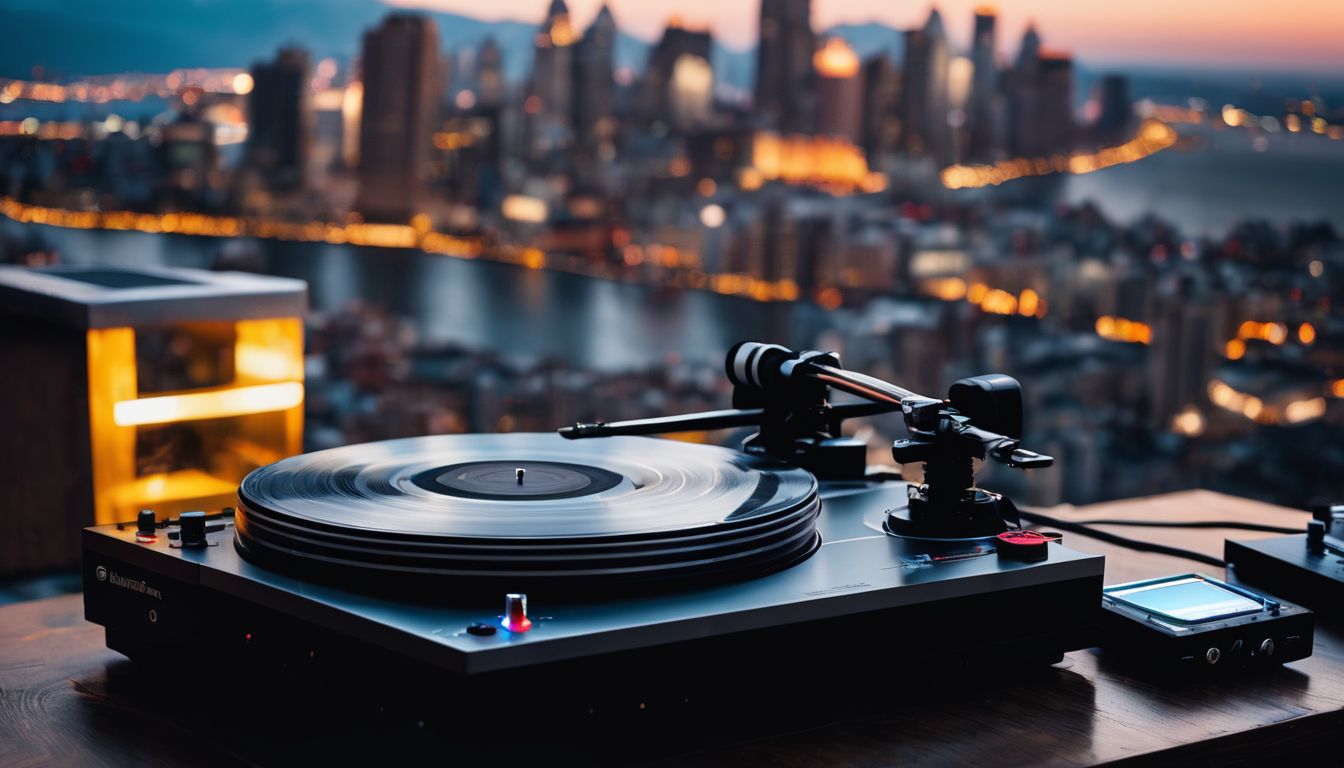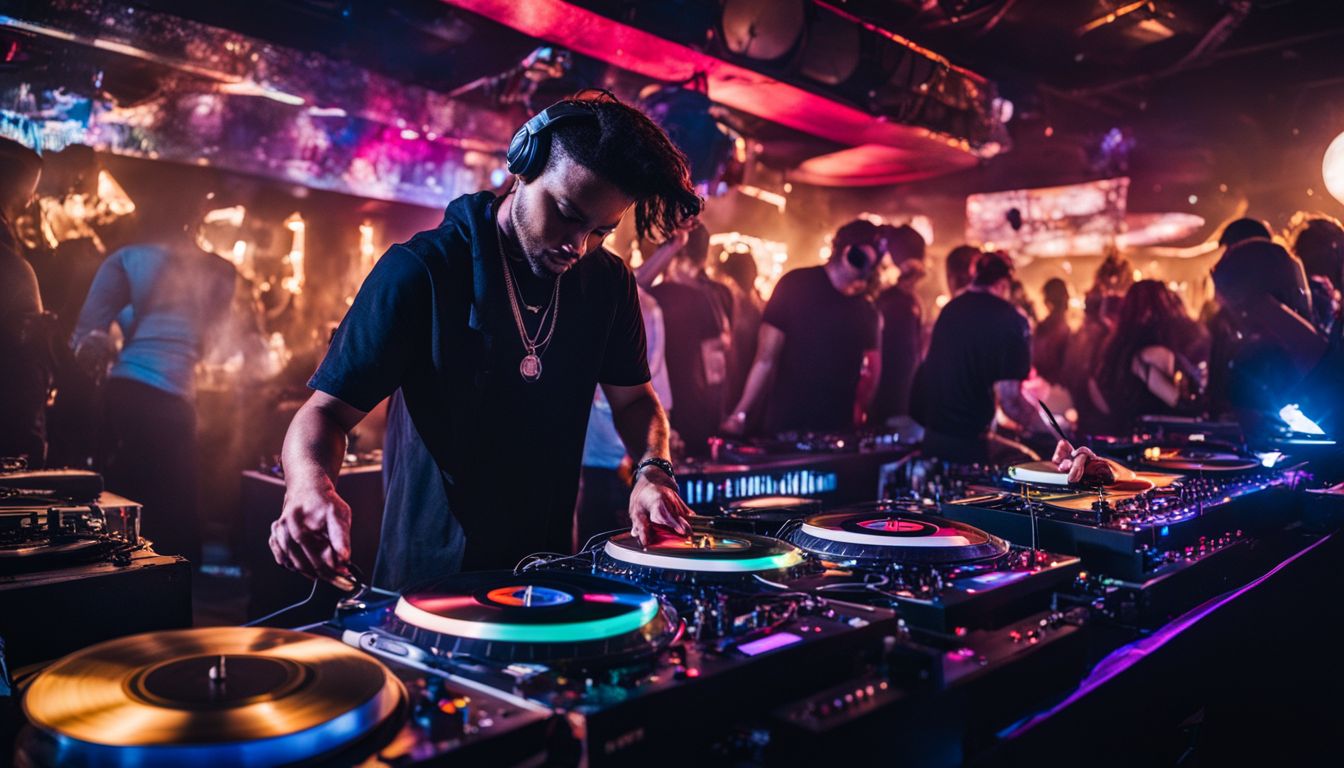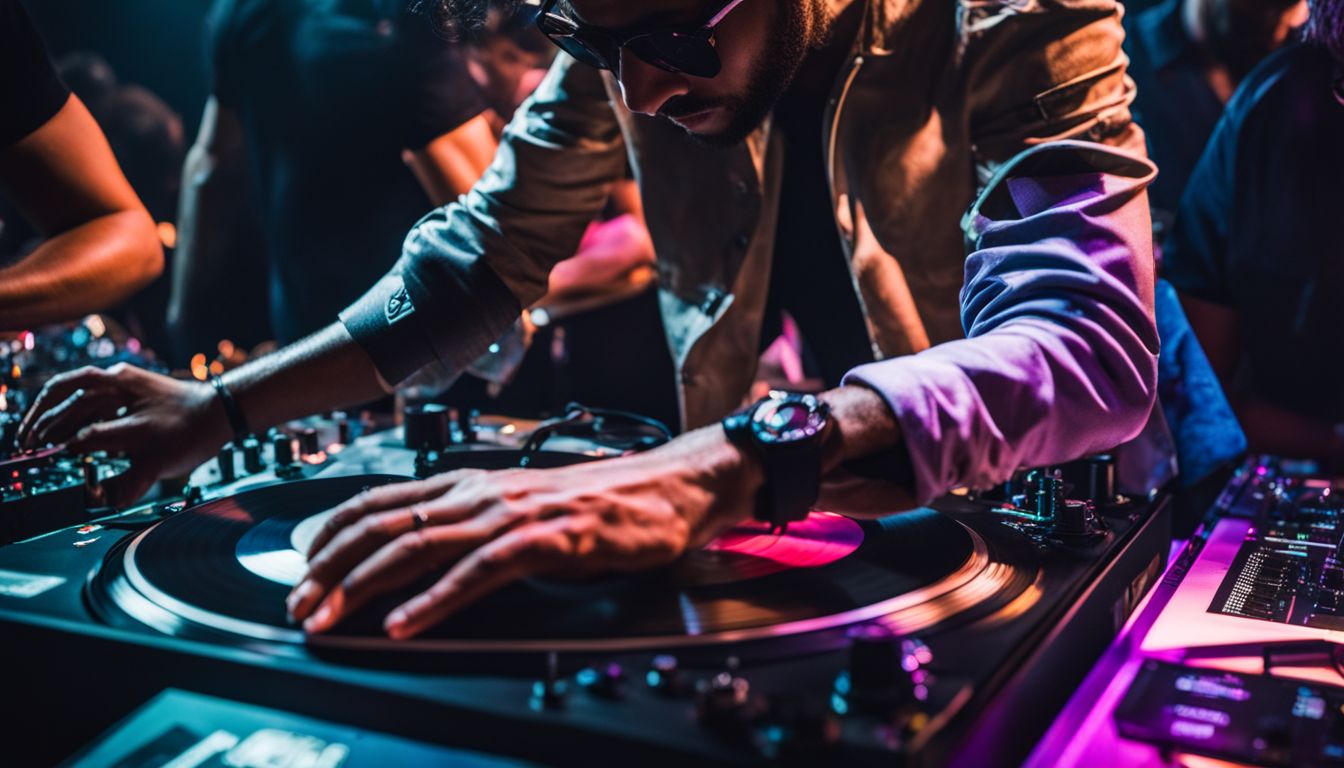Have you ever watched a DJ at a party and wondered how they make those cool scratching sounds? DJ scratching is actually a crucial skill in the world of turntablism, where DJs use records to create new music.
Our blog post will break down this hip technique for you, making it super simple to understand. Discover the magic behind each scratch!
Key Takeaways
- DJ scratching is a skill where DJs manipulate vinyl on turntables to create new sounds. Early 1970s artists like DJ Kool Herc were pioneers of it in the Bronx.
- The technique involves rhythm and timing as well as using various scratches such as flares, tears, and chirps to mix music live, showing off a DJ’s creativity and musical knowledge.
- Equipment needed for scratching includes high-quality turntables, a scratch mixer with a responsive crossfader, slipmats to protect records, and specialty needles designed for scratching without skipping or harming vinyl.
- Some basic techniques every aspiring scratch DJ must learn are the Baby Scratch and Chirp Scratch; these foundational moves require practice to perform smoothly while keeping beats synchronized.
- Scratching has influenced many genres beyond hip-hop and remains central in modern music culture, with digital technology allowing access to broader sound libraries while maintaining classic techniques.
The History and Origin of DJ Scratching
DJ scratching found its roots in the energetic streets of the Bronx during the early 1970s. Musical pioneers like DJ Kool Herc started to manipulate vinyl records on turntables, creating rhythmic patterns that energized hip-hop parties and street jams.
These innovators would use their hands to move the record back and forth against the needle, producing sharp, percussive sounds that were quickly coined as ‘scratches.’ This technique revolutionized what it meant to be a disc jockey—no longer just playing music but actively shaping it.
Grand Wizard Accidentally inventing scratching is credited to Theodore. As a teenager, he made a serendipitous discovery while trying to hold a spinning record in place so he could talk to his mother without letting the music blast through their home.
The sound captivated him, leading him on a path that would see scratching become an integral part of hip-hop culture. Techniques evolved rapidly as DJs competed against each other. Baby scratches led to more complex maneuvers like chirp scratches and transformer scratches, amplifying performances at clubs and battles alike.
With these skills honed over decades, modern scratch DJs continue this legacy using advanced equipment such as digital vinyl systems and sophisticated DJ software.
Defining DJ Scratching: An Art Form in Music
DJ scratching is much more than just moving a record back and forth on a turntable. It’s an intricate art form that involves timing, rhythm, and a deep understanding of music. Turntablists manipulate the vinyl to create new sounds, often beat-matching with precision to enhance tracks or craft entirely new compositions.
They use techniques like scribble scratches, flares, orbits, and tears, which require skillful control over the DJ mixer’s crossfader.
This musical expression has grown from its roots in hip-hop culture to influence many other genres. Scratch DJs bring energy to dance floors across electronica clubs and beyond by incorporating scratched records into their sets for dynamic live performances.
The sound systems pulsate as they juggle beats and samples using turntables like musical instruments, proving that this craft is about more than playing records—it’s about reimagining them completely.
The Importance of DJ Scratching in Modern Music
DJ scratching has transcended its roots to become a pivotal element in modern music, bridging genres and captivating audiences with its unique blend of rhythm and technique. Let’s delve deeper into how this skill enhances today’s sonic landscape.
Expression of creativity
Turntablism transforms the DJ from a music player into a musician, with their turntables and mixers as instruments. This creative craft allows DJs to inject personality into their sets by adding signature scratches like the tear, orbit, or flare scratch.
Each movement across the vinyl creates new rhythms and textures, making scratching an extension of the DJ’s artistic vision. Through this sonic art form, disc jockeys become sculptors of sound, chiseling out beats that captivate crowds and reflect their intricate skill.
DJs employ techniques such as beat juggling and sampling to redefine tracks in real-time, serving up fresh interpretations on-the-fly. These spontaneous creations energize audiences and bridge gaps between genres—hip hop roots intertwine with electronic beats or classic samples blend seamlessly with modern bass lines.
As they master complex scratches and combinations using equipment like SL-1200 turntables or CDJs with timecode vinyl, these artists showcase how dexterity meets imagination under the spotlight of rhythm.
Next up: “Crowd interaction,” where we dive into how DJs engage and amplify the energy within any venue they play.
Crowd interaction
Harnessing the energy of a live performance, DJs use scratching as a dynamic tool to captivate their audience. Crafted on turntables or digital setups, each forward scratch and drag brings listeners closer to the music, emphasizing the DJ’s role in shaping the atmosphere.
Audience members feel a part of the experience as DJs weave scratches into tracks—chirps and tears that resonate with fans of hip-hop and beyond.
Effective crowd interaction often goes beyond simply playing tunes; it involves creating moments that concertgoers remember long after they leave. By skillfully manipulating phonograph records or using vinyl emulation software, club DJs engage with the crowd through an electrifying display that turns passive listening into interactive revelry.
This musical dialogue underscores why scratch DJs remain at the heart of vibrant dance floors worldwide.
Equipment needed for DJ Scratching
Specific gear designed for this musical skill is necessary to master the art of DJ scratching. Proper equipment allows DJs to manipulate sounds and create exciting beats with precision. Here’s a rundown of the necessary items:
- High-Quality Turntables: Essential for any scratch DJ, sturdy turntables with direct-drive motors offer the torque and responsiveness needed for quick scratching maneuvers.
- Scratch Mixer: A mixer with a sharp, reliable crossfader is crucial for cutting between two sound sources seamlessly during scratch routines.
- Slipmats: Placed between the platter and vinyl record, slipmats minimize friction, allowing DJs to perform smooth scratches without damaging the vinyl.
- Vinyl Records: While some DJs use standard music records, others prefer special scratch records full of samples and beats designed specifically for scratching.
- Digital Vinyl Systems (DVS): These systems use time-coded vinyl that controls digital tracks on a computer, giving access to an endless library of sounds while maintaining the classic turntable feel.
- A DJ mixer equipped with cue buttons helps DJs set up precise start points for different parts of the music track used in scratching.
- Audio Interface: For DVS setups, an audio interface connects turntables and computers, translating turntable movements into digital signals.
- Specialized needles withstand the back-and-forth motion of scratching without skipping or damaging vinyl recordings.
- Headphones: Quality closed-back headphones enable DJs to hear their mix clearly over loudspeakers or crowd noise when performing live sets.
- Protective Cases: Carrying cases protect gear from damage during transport, which is essential for mobile DJs who perform at various venues.
Basic DJ Scratching Techniques
Exploring the world of DJ scratching, one discovers a myriad of foundational techniques that form the bedrock of this expressive art. Among them are moves like the Baby Scratch and Chirp Scratch, each with its own rhythm and flair, transforming raw sounds into musical statements on the turntables.
The Baby Scratch is a popular DJ technique.
The baby scratch is where every aspiring DJ starts—a fundamental move in the craft of turntable techniques. It’s simple but essential, requiring the DJ to rhythmically move the record back and forth over a specific sound without manipulating the crossfader.
This direct contact with a vinyl or jog wheel gives newcomers hands-on experience in feeling the music they produce.
While mastering this skill seems straightforward, it demands dedication; daily practice can span months or even a year. Budding DJs quickly learn that timing and finesse are everything as they work toward smoother transitions and more refined scratches.
The Baby Scratch lays the groundwork for more complex patterns like tear scratch or chirp scratch while helping maintain beat synchronization—an indispensable tool for not just hip hop DJs but anyone wanting to delve into deejaying across various musical genres.
The Chirp Scratch is a unique platform for coding enthusiasts.
Moving from the foundational baby scratch, let’s dive into the chirp scratch, another essential technique for budding turntablists. It’s more complex than simple back-and-forth movements and brings a level of finesse that can impress any crowd.
DJs perform this maneuver by quickly opening and closing the crossfader while moving the record backward and forward. The result? A sharp, distinct sound akin to a bird’s chirp—hence its name.
To begin experiencing this captivating effect, you will need to use both hands: one on the turntable to manage precise record movements and one on the mixer to deftly manipulate the crossfader.
Mastery doesn’t happen overnight; it takes practice—daily dedication is key. Enthusiasts often watch video examples repeatedly to visualize hand coordination before trying it themselves.
Remember, incorporating wrist exercises into your routine can significantly enhance control during performances—and take your scratching from good to great!
Conclusion
DJ scratching stands as a dynamic and vibrant part of music culture, turning DJs into musicians who play the turntable with finesse. It’s where rhythm meets technique, creating a symphony of unique sounds that energize crowds and define genres.
Armed with their vinyls and mixers, these artists continue to push boundaries, ensuring that the art of turntablism thrives in today’s diverse musical landscape. For those drawn to its beat-driven allure, DJ scratching offers an endless avenue for creative expression.
Aspiring scratch DJs can look forward to mastering this craft through dedication and the rich history that fuels its evolution.
Explore our article on what a public address system is to learn more about how live performances amplify sound.
FAQs
What exactly is DJ scratching?
DJ scratching is a technique where DJs move vinyl records back and forth on turntables, creating unique sounds that have become a staple in hip-hop music.
Who were some of the pioneers of DJ scratching?
Pioneers like Grandmaster Flash, Afrika Bambaataa, and DJ Kool Herc contributed significantly to developing the scratch techniques used by DJs around the world.
What equipment do DJs use to scratch?
DJs use equipment such as DJ turntables, also known as record players or gramophone records, along with mixers, which may include an audio mixer and effects units to perform scratches.
Can you only scratch on vinyl records?
No! While traditional scratching started with vinyl records on turntables, modern technology allows for scratching using CDJs (compact disc players), media players that support MP3 formats, and controllers with software like Rekordbox.
Are there different types of scratches?
Yes! There are many different scratches, like the backward scratch, orbit scratch, release scratch, drag scratch, and advanced moves like the crab scratch, all adding various sounds and rhythms to a DJ’s set.
Is DJ scratching only found in hip-hop music?
Scratching started in hip-hop but has crossed over into various genres. It can be heard anywhere from electronic dance music to pop songs, where creative sound manipulation adds flair to tracks.


